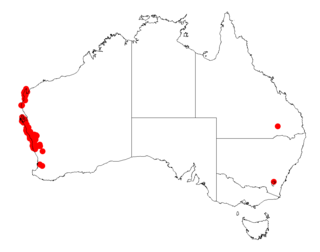
Acacia effusifolia is a shrub or tree belonging to the genus Acacia and the subgenus Juliflorae. It is native to an area in the Mid West and the Wheatbelt regions of Western Australia.

Acacia hopperiana is a small tree or shrub belonging to the genus Acacia and the subgenus Juliflorae that is endemic to western Australia.

Acacia multispicata, commonly known as spiked wattle, is a shrub belonging to the genus Acacia and the subgenus Juliflorae that is endemic to south western Australia.

Acacia oncinocarpa is a shrub or tree belonging to the genus Acacia and the subgenus Juliflorae that is endemic to northern Australia.

Acacia orthocarpa, also commonly known as Pilbara weeping wattle, needle-leaf wattle or straight-podded wattle, is a shrub or tree belonging to the genus Acacia and the subgenus Juliflorae that is endemic to tropical parts of northern Australia. The indigenous Nyangumarta peoples know it as yartupu.

Acacia ptychophylla is a shrub belonging to the genus Acacia and the subgenus Juliflorae the is endemic to arid areas of north western Australia.

Acacia richardsii is a shrub belonging to the genus Acacia and the subgenus Juliflorae that is endemic to north western Australia.
Acacia seclusa, commonly known as saw range wattle, is a small tree belonging to the genus Acacia and the subgenus Juliflorae that is endemic to northern Australia.
Acacia stanleyi, commonly known as Stanley's rock wattle, is a shrub belonging to the genus Acacia and the subgenus Juliflorae that is endemic to south western Australia.

Acacia tenuispica is a tree or shrub belonging to the genus Acacia and the subgenus Juliflorae that is endemic to north western Australia.

Acacia spathulifolia commonly known as Gold carpet or the Gold carpet wattle is a shrub of the genus Acacia and the subgenus Phyllodineae that is endemic to coastal parts of western Australia.
Acacia toondulya is a tree belonging to the genus Acacia and the subgenus Phyllodineae native to southern Australia.

Acacia brassii is a shrub belonging to the genus Acacia and the subgenus Juliflorae that is native to north eastern Australia.

Acacia calyculata is a shrub belonging to the genus Acacia and the subgenus Juliflorae that is native to north eastern Australia.

Acacia echinuliflora is a tree belonging to the genus Acacia and the subgenus Juliflorae that is native to northern Australia.

Acacia sparsiflora, also known as currawong or currawang, is a tree belonging to the genus Acacia and the subgenus Juliflorae that is native to a large area in eastern Australia.

Acacia striatifolia is a shrub or tree belonging to the genus Acacia and the subgenus Juliflorae that is native to north eastern Australia.

Acacia polystachya is a tree belonging to the genus Acacia and the subgenus Juliflorae that is native to north eastern Australia.

Acacia rhodoxylon, also known as rosewood, ringy rosewood or spear wattle, is a tree belonging to the genus Acacia and the subgenus Juliflorae that is native to north eastern Australia.

Acacia legnota, also known as heath wattle, is a shrub of the genus Acacia and the subgenus Plurinerves that is endemic to an area of north eastern Australia.

















